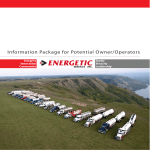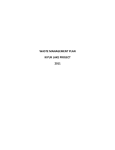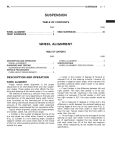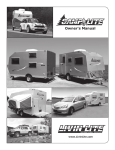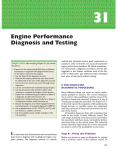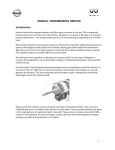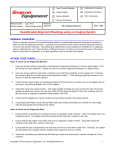Download Truck and Transport Mechanic Practice
Transcript
Truck and Transport Mechanic Practice Interprovincial Red Seal Exam Disclaimer: This is NOT an Interprovincial Standards (Red Seal) Examination. This is a practice examination that has been developed using similar weighting, question distribution, question taxonomies and question styles to that of a red seal examination. Success on this examination will NOT result in certification or qualification. This examination is intended to be used for self-assessment in preparation for attempting a red seal examination. More information about the standard that the red seal examination is based on may be found within the National Occupational Analysis for the occupation at www.red-seal.ca. Section 1 OCCUPATIONAL SKILLS 1. What procedure should be followed before using a bench grinder? Dress stone and set rest with minimum clearance of 3 mm (1/8"). Dress stone and set rest with maximum clearance of 1.6 mm (1/16"). Set rest with minimum clearance of 3 mm (1/8") and dress stone. Set rest with maximum clearance of 1.6 mm (1/16") and dress stone. 2. What should be inspected on a chain sling before the technician uses it? Length and size. Bends and color. Elongation and twist. Date of manufacture and expiry date. 3. Where would a technician obtain information on a recurring problem? Shop foreman. The service manual. The operators manual. Technical service bulletins. -2- 4. What is the proper procedure to clean up a coolant spill? Cover with floor dry. Wash into floor drain. Contain with a floor dam. Refer to MSDS information. 5. Where is the data link located on a highway tractor? Left side of glove box. In the fuse panel. Beside the Electronic Control Unit. Left lower dash panel. 6. What steps should be followed when utilizing Torque-to-Yield fasteners? Lubricate threads and torque to specifications. Rotate to specified degrees and torque to specifications. Torque to specifications and rotate to specified degrees. Tighten a specified number of degrees with an impact. 7. What type of hose or tubing should be used on the compressor air outlet? Nylon tubing. Stainless steel tubing. Reinforced rubber air brake hose. Braided stainless steel with a Teflon inner lining. 8. What type of seal would be considered as a static seal? Oil filter seal. Rear wheel seal. Rear crankshaft seal. Transmission output shaft seal. Apprenticeship and Student Aid – HET Truck and Transport Mechanic IP practice exam -3- Section 2 ENGINE AND SUPPORTING SYSTEMS 9. What would be indicated by engine oil contaminated with coolant? Cracked dry liner. Leaking liner O-rings. Leaking oil cooler core. Cracked liner counter-bore. 10. What will cause excessive crankcase blow-by? Worn oil control rings. Excessive engine speed. Worn compression rings. A plugged crankcase filter. 11. What would be the cause of a failed cylinder head gasket? Rolled liner O-rings. Cracked cylinder head. Insufficient liner height. Turbocharger waste-gate stuck open. 12. What would indicate a faulty vacuum valve in the radiator cap? Engine overheating. Collapsed radiator hose. Extended warm up time. Overfilled coolant reservoir. Apprenticeship and Student Aid – HET Truck and Transport Mechanic IP practice exam -4- 13. What component is leaking when engine oil is found in the coolant? Injector cups. Oil cooler core. After cooler core. Cylinder liner O-rings. 14. What would indicate that the engine oil pump regulating valve is stuck open? Increased oil pressure. Decreased oil pressure. Increased oil consumption. Decreased oil consumption. 15. What will cause a diesel engine to run rough and stall? Poor fuel quality. A plugged return line. Air in the fuel system. Low transfer pump pressure. 16. What is the cause of low fuel transfer pump pressure? Plugged fuel filter. Return line restriction. Leaking fuel tank vent. Regulating valve stuck closed. 17. Which will cause a diesel engine to have low power output? Cracked intercooler. Excessive turbocharger speed. Leaking turbocharger exhaust outlet. Turbocharger waste-gate valve stuck closed. Apprenticeship and Student Aid – HET Truck and Transport Mechanic IP practice exam -5- 18. What must be used on an engine equipped with a diesel particulate filter (DPF)? Fuel lubricity additive. Low sulphur Diesel fuel. 5% Bio-Diesel/Ethanol blend. Ultra low sulphur diesel fuel. 19. What will happen when the soot loading on a diesel particulate filter (DPF) exceeds 80%? Reduced fuel economy. A forced manual regeneration. Engine de-rate and shutdown. The DPF will bypass automatically. 20. What exhaust smoke color would indicate a leaking "Dosing" valve? Blue. Black. White. Brown. 21. What does the second number in a SAE fault code (e.g. 100 – 4) indicate? Type of circuit failure. Type of sensor circuit. Message identification. Number of fault occurrences. 22. What would happen to the engine if the ECM does not receive a speed/timing signal? Exceed governed speed. Hunt at governed speed. Start and run at idle speed. Cranks but does not start. Apprenticeship and Student Aid – HET Truck and Transport Mechanic IP practice exam -6- 23. What should be done when the depth of a cylinder block liner counterbore varies 0.003" in four places? Machine and shim the counterbore. Hone the block for an oversized liner. Nothing - measurements are acceptable. Install a tapered shim to even out liner height. 24. When replacing main bearings on an engine, what should be checked after torquing each main bearing cap? Clutch free pedal. Crankshaft deflection. Connecting rod side clearance. Free rotation of the crankshaft. 25. What type of test is used to verify cooling system leakage? Flow. Pressure. Chemical. Temperature. 26. When should an oil sample be collected? Mid-stream. Only when necessary. When a failure occurs. As soon as the drain plug is removed. 27. What should be done before removing an injection nozzle for testing or repair? Check the injection pump timing. Change the primary fuel filter. Clean the area around the injector thoroughly. Bend the injection line slightly for clearance. Apprenticeship and Student Aid – HET Truck and Transport Mechanic IP practice exam -7- 28. How is an intake manifold pressure test performed on a turbocharged engine? Install a gauge at the turbine housing outlet and load the engine. Install a gauge at the compressor housing outlet and load the engine. Install a gauge at the compressor housing inlet and load the engine. Install a gauge at the compressor housing outlet and run the engine at high idle. 29. What is the correct service procedure when the DPF warning light is flashing? Remove DPF for cleaning. Refill the Urea reservoir. Perform a manual regeneration. Run the engine at high idle. 30. When servicing the SCR system what is a necessary step? Wear PPE to avoid electrical shock. Wear PPE for protection from high temperatures. Prevent skin and eye contact with the DEF (Urea). Remove loose clothing to prevent contact with the DEF (Urea). 31. What precaution must be taken before welding on a vehicle with electronic engine controls? Record all fault codes. Attach the welder's ground clamp to the ECM. Attach the welding connections using reverse polarity. Disconnect the ECM from the vehicles power supply. 32. What is done before replacing a common rail fuel injector? Release residual pressure in the fuel pump supply circuit. Release the residual pressure in the accumulator (high pressure rail). Purge the accumulator (high pressure rail) to prevent fuel oil dilution. Replace the fuel filters to prevent contamination of the new injector. Apprenticeship and Student Aid – HET Truck and Transport Mechanic IP practice exam -8- Section 3 AIR SYSTEMS AND BRAKES 33. What will cause air to leak out of the relay valve with the park brake released and the service brake not applied? Ruptured service brake diaphragm. Ruptured Park/Emergency brake diaphragm. Faulty secondary reservoir blow-off valve. Parking/Emergency brake chamber pushrod seal leak. 34. What will cause the wet tank air pressure to leak down overnight? A faulty air governor valve. A faulty one way check valve. A faulty service brake diaphragm. A leak in the air compressor outlet line. 35. What is indicated by excessive air reservoir build up time? A plugged air drier. Air governor set too low. A leaking service relay valve. A restricted compressor air inlet. 36. What will cause engine coolant to be present in the air system tanks? Cracked intercooler. Leaking engine head gasket. Plugged air drier desiccant. Air compressor head gasket. Apprenticeship and Student Aid – HET Truck and Transport Mechanic IP practice exam -9- 37. What will cause excessive air pressure drop during a brake application? Brakes adjusted to tight. Excessive pushrod travel. Air governor cut out set too low. Service tank relief valve leaking. 38. What would cause hydraulic drum brakes to "fade" during application? Low fluid level. Excessive temperature. Leaking residual check valves. Weak brake shoe return springs. 39. What would be indicated if the ABS dash light goes out after 6 km/h? A faulty ECU. A faulty wheel speed sensor. No systems faults are present. Faulty brake modulator valve. 40. What will cause an air brake to "cam over" during application? Worn cam bushings. Worn drums and shoes. Slack adjuster set too tight. Excessive application pressure. 41. What will cause an engine braking system to operate only in the first and third stage? Faulty dash switch. Faulty brake switch. Faulty clutch switch. Faulty throttle switch. Apprenticeship and Student Aid – HET Truck and Transport Mechanic IP practice exam - 10 - 42. What would be indicated if one engine brake head continues to operate after the brake switch is turned off? Faulty clutch switch. Solenoid valve stuck closed. Broken master piston spring. Broken hydraulic control valve springs. 43. What would happen if an exhaust brake failed to open after application? Engine would stall. Ruptured exhaust tubing. Turbocharger over-speed. Elevated exhaust temperature. 44. What will cause poor engine braking power? Insufficient slave piston lash. Excessive master piston lash. Excessive engine oil pressure. Faulty throttle position sensor. 45. What must be done daily with an air brake equipped unit? Drain air tanks. Adjust the brakes. Pressure test the compressor. Rotate the slack adjusters. 46. What is the procedure for checking governor operation? Check manufacture specifications then fan the brakes. Remove governor from compressor and check governor spring tension. Reduce air and record compressor cut in, build pressure and record cut out. Fan the brakes until cut in pressure is achieved then check compressor run time. Apprenticeship and Student Aid – HET Truck and Transport Mechanic IP practice exam - 11 - 47. What is done when replacing the double check valve between the primary and secondary air tanks? Drain air system and replace valve. Apply park brake and replace valve. Clean around valve and replace valve. Remove primary tank and then replace valve. 48. When referring to an anti-lock air brake system which of the following would be an actuator? Brake lights. Axle tone ring. Wheel speed sensor. Brake modulator valve. 49. Which procedure must be done when servicing a wheel hub on a highway tractor equipped with antilock brakes? Adjust the tone ring. Replace the tone ring. Reset the speed sensor depth. Replace the wheel speed sensor. 50. What would indicate that bleeding procedure of a hydraulic brake system has been completed? The brake pedal application height is correct. The brake pedal will "pump-up" to a solid feel. The fluid level in the master cylinder stops dropping. The fluid escaping at the wheel cylinder runs clear. 51. What must be done when replacing S-cams on an air brake equipped vehicle? Replace the automatic slack adjusters. Ensure that S-cams have the correct rotation designation. Inspect or replace the service brake chamber diaphragms. Turn the S-cam bushings 180º to promote even wear. Apprenticeship and Student Aid – HET Truck and Transport Mechanic IP practice exam - 12 - 52. Which of the following describes a function of an engine compression brake? Closes the intake valve on the power stroke. Closes the exhaust valve on the power stroke. Opens the intake valve on the compression stroke. Opens the exhaust valve on the compression stroke. 53. What do you do prior to setting the slave valve clearance of an engine compression brake? Position the piston of the cylinder to be adjusted at TDC. Ensure that the intake valves are fully closed on the cylinder to be adjusted. Ensure that the exhaust valves are fully closed on the cylinder to be adjusted. Cycle the solenoid valve to purge all the oil out of the engine brake housing. 54. How should a clutch switch be adjusted? So that the switch is opened when the clutch brake is engaged. So that the switch is closed when the brake pedal is depressed. So that the switch is closed when the clutch pedal is depressed. So that the switch is opened when the clutch pedal is depressed. 55. What should be done after installing an exhaust brake? Adjust the intake and exhaust valves. Measure the exhaust system temperature. Measure exhaust backpressure before the brake housing. Measure exhaust backpressure after the brake housing. Apprenticeship and Student Aid – HET Truck and Transport Mechanic IP practice exam - 13 - Section 4 ELECTRICAL AND ELECTRONIC SYSTEMS 56. What would cause a battery to continuously show signs of moisture near the vent caps? Overfilling of the cells. Voltage regulator set too high. Open stator winding in the alternator. Dirty connections at the battery terminals. 57. What would be indicated by a difference of 2 volts between the alternator output terminal and the positive battery terminal? A sulphated battery. Voltage regulator is set too low. High resistance in the cables and connections. Alternator current output is below specifications. 58. How would a shorted diode affect alternator output? System voltage would be out of specifications. The starter would not be able to crank the engine. Alternator current output would be above specifications. Alternator current output would be below specifications. 59. What would be indicated by a slow cranking speed and excessive current draw? Batteries are sulphated. Engine is hard to crank. A shorted starter solenoid. Engine oil has a low viscosity. Apprenticeship and Student Aid – HET Truck and Transport Mechanic IP practice exam - 14 - 60. What is indicated if the battery terminal voltage drops below 9.6 volts during cranking? Battery low state of charge. Starter has low internal resistance. The starter has a loose ground connection . Battery cables have excessive voltage drop. 61. What would cause repeated cycling of a circuit breaker? Low current flow. High system voltage. Short circuit to ground. Corroded ground connection . 62. Using an ohmmeter, what test results would indicate an inoperable block heater? Continuity between both heater terminals. Infinite resistance between both heater terminals. No continuity between either heater terminal and ground. Infinite resistance between either heater terminal and ground. 63. What is indicated if system voltage is present across the terminals of a toggle switch in the "on position"? Circuit is open. Normal condition. Switch contacts are open. Switch contacts are shorted. 64. What should be done before performing a battery load test? Charge the battery for 15 seconds. Discharge the battery for 30 seconds. Determine the batteries state of charge. Check the condition of the battery cables. Apprenticeship and Student Aid – HET Truck and Transport Mechanic IP practice exam - 15 - 65. What is the procedure for checking charging system regulated voltage? Use a carbon pile to control alternator output. Measure system voltage with engine at 1000 rpm. Turn on all electrical loads and run engine at 1000 rpm. Measure system voltage while alternator output is below 1/3. 66. What is done to test for voltage drops in the cranking motor circuit? Check and clean all connections. Measure starter cable resistance with an ohmmeter. Check voltage across the cables while the engine is running. Compare battery voltage to starter terminal voltage while cranking the engine. 67. What is done when adding additional loads (such as lights) to a circuit? Increase switch rating. Increase circuit protection. Size the conductors to the load. Balance the load from one side to the other. 68. What procedure should be used to repair several damaged conductors in a wiring harness? Solder and tape the wires. Twist and insulate the wires. Solder the wires with staggered joints. Stagger splice joints and insulate the wires. 69. What will cause a gasoline engine to run fine at idle but miss under load? A plugged air cleaner. EGR valve stuck open. A defective knock sensor. High resistance plug wires. Apprenticeship and Student Aid – HET Truck and Transport Mechanic IP practice exam - 16 - 70. What is indicated if the cruise control system will not engage (set)? Open clutch switch contacts. Defective park brake switch. Inaccurate speedometer calibration. Faulty throttle position sensor signal. 71. What would cause an accidental deployment of the SRS system? Boosting batteries. Fast charging batteries. Electrostatic discharge. Load testing the batteries. 72. What is indicated by a weak signal from a reluctance type speed sensor? Sensor coil is open. Sensor coil is shorted. Air gap is less than specified. Loose sensor ground connection. 73. What should be done to diagnose a system malfunction when no fault codes have been generated? Replace the batteries. Replace the ECU module. Reprogram the ECU module. Perform symptom based tests. 74. What would be indicated when an ohmmeter connected across the J1939 backbone reads higher than normal resistance? One terminating resistor is open. High resistance in the CAN stubs. One terminating resistor is shorted. A short in the backbone wiring harness. Apprenticeship and Student Aid – HET Truck and Transport Mechanic IP practice exam - 17 - 75. What would cause a network error message indicating one module is offline? Open network harness fuse. Open backbone wiring harness. Excessive network signal traffic. High resistance module power connection. 76. What should be done before installing spark plugs? Measure the reach. Check the heat range. Adjust the electrode gap. Torque to specifications. 77. What must be connected when working with electronic circuits? A test harness. A surge protector. A static ground strap. A module housing ground. 78. What is the procedure for adjusting speed sensor air gap on the output shaft of a transmission? Bottom the sensor lightly on a tone ring tooth, back out 1/4 – 1/2 turn. Turn the sensor towards the tone ring teeth to achieve running clearance. Turn the sensor in until there is a light drag on a 0.4 mm (0.016") feeler gauge. Bottom out the sensor and back off 1/4 turn while rotating the driveshaft by hand. 79. What is the procedure for repairing an open J1939 data link backbone? Solder and heat shrink the wires. Install new terminating resistors. Twist the wires together at 1 ft. intervals. Splice wires while maintaining the twist rate. Apprenticeship and Student Aid – HET Truck and Transport Mechanic IP practice exam - 18 - 80. What should not be done when downloading new information to an ECM? Unplug the data link. Connect the data link. Leave the key-switch on. Change the computer settings. Apprenticeship and Student Aid – HET Truck and Transport Mechanic IP practice exam - 19 - Section 5 DRIVE TRAIN 81. What would cause a double disc clutch to rattle when the clutch is released? Warped clutch discs. Excessive flywheel run-out. Excessive drive lug clearance. Clutch brake adjusted too high. 82. What would be indicated by a grinding noise when trying to shift a five speed synchronized transmission from 4th to 5th gear? Worn blocking rings. Worn main drive gear teeth. Worn countershaft drive gear teeth. Insufficient clutch free pedal travel. 83. What would cause a standard transmission to select two gears at the same time? Worn shift rail detents. Worn shift lever finger. Worn shift rail interlocks. Weak reverse plunger spring. 84. What would be indicated if an automatic transmission will go into low gear but fails to upshift? Worn clutch packs. Low governor pressure. A sticking shift selector. Insufficient throttle valve adjustment. Apprenticeship and Student Aid – HET Truck and Transport Mechanic IP practice exam - 20 - 85. What will cause a delay when shifting an automatic transmission from neutral to drive or reverse? Low oil level. High oil level. Worn torque converter seals. Worn low speed clutch pack. 86. What would allow the engine to start in any gear on a vehicle equipped with an auto-shift transmission? Shift finger stuck in neutral. A defective start enable relay. A defective gear indicator display. The gear select motor stuck in neutral. 87. What would prevent an upshift in the main box? Low air pressure. No clutch free-play. Faulty speed sensor. Faulty gear indicator. 88. What would cause a clunking noise when engaging a gear in a forward or reverse direction? Worn slip joint splines. Out of phase driveline. Worn out steady bearing. Incorrect air suspension height. 89. What would be indicated by excessive noise from the rear axle during acceleration? Worn axle splines. Excessive backlash. Insufficient backlash. A defective axle bearing. Apprenticeship and Student Aid – HET Truck and Transport Mechanic IP practice exam - 21 - 90. What would cause chipped and broken inter-axle differential lock clutching (dog) teeth? Cornering with the inter-axle differential locked. Spinning one wheel during poor traction conditions. Shifting the inter-axle differential lock during wheel spin. Shifting out of inter-axle differential lock on dry pavement. 91. When setting a double disc angle spring clutch, which adjustment should be performed first? Free pedal. Clutch brake. Linkage length. Upper pedal stop. 92. What must be done when installing a countershaft that is supported with tapered roller bearings? Measure and set shaft endplay. Check and adjust rolling torque. Measure countershaft gear clearance. Measure reverse idler gear clearance. 93. What procedure must be done when assembling a twin countershaft transmission main section? Time the auxiliary drive gear. Set the main-shaft bearing clearance. Time the main drive gear to the main-shaft. Time the countershafts to the main drive gear. Apprenticeship and Student Aid – HET Truck and Transport Mechanic IP practice exam - 22 - 94. What is the final step when assembling a clutch drum? Line up friction disc splines. Measure clutch pack clearance. Install wave spring and retaining ring. Alternate position of friction discs and steels. 95. After servicing an automated transmission with a neutral interlock system what safety precaution should be taken before attempting to start the truck. Check electrical harness connections and routing. Verify that the shift control panel lights are functional. Clear all fault codes and reprogram the transmission ECU. Set the park brake before turning the key “on” or attempting to “start”. 96. What is the next step after replacing an XY shifter assembly? Reprogram the ECU. Check the fluid level. Perform shifter calibration. Perform inertia brake calibration. 97. What is the first step to correct a driveline vibration? Replace the U-joints. Replace the steady bearing. Measure all driveline angles. Inspect driveline components. 98. What should be done if the tooth pattern of a hypoid gear set shows excessive face contact? Move the pinion in. Move the pinion out. Move the ring gear closer to the pinion. Move the ring gear away from the pinion. Apprenticeship and Student Aid – HET Truck and Transport Mechanic IP practice exam - 23 - 99. Which procedure will allow you to safely disassemble a traction controlled differential assembly? Mark the case haves for orientation. Lift the carrier with an approved sling. Cage the case halves before removing the bolts. Remove the ring gear before separating the case halves. Apprenticeship and Student Aid – HET Truck and Transport Mechanic IP practice exam - 24 - Section 6 STEERING, CHASSIS/FRAMES, SUSPENSION, WHEELS HUBS AND TIRES 100. What would be indicated by excessive play in the steering wheel? Worn kingpins. Loose wheel bearings. Loose wheel assembly. Worn or misadjusted steering gear. 101. What would be indicated by excessive steering effort? Excessive toe-in. Excessive tire pressure. Misadjusted steering stops. A leaking pump relief valve. 102. What will cause abnormal tire wear on a truck that has had the wheelbase lengthened? Excessive caster. Insufficient toe-in. Incorrect steering radius. Incorrect steering arm angle (ackerman). 103. What method is used to check frame alignment? Tire scrub. Diagonal measurement. Front to rear axle stagger. Tandem axle centerline measurement. Apprenticeship and Student Aid – HET Truck and Transport Mechanic IP practice exam - 25 - 104. What should be checked if there are broken frame gussets? Frame rail fasteners. Fuel tank mountings. Vehicle loading and application. Engine and transmission mountings. 105. What will cause "dog tracking" on the rear of a tandem axle tractor? A broken shock mount. Worn torque rod bushings. Incorrect suspension height. Worn walking beam bushings. 106. What would be indicated by excessive jouncing when a truck encounters rough terrain? Worn spring pins. Worn shock absorbers. Worn torque arm bushings. Weak or broken leaf springs. 107. What should be done with a cracked fifth wheel plate? Discarded/replaced. Replace the kingpin. Preheated and welded. Install new jaws and bushings. 108. What would cause air to leak from a no slack pintle hitch? Worn pushrod. Ruptured diaphragm. Excessive pintle wear. Broken lock mechanism. Apprenticeship and Student Aid – HET Truck and Transport Mechanic IP practice exam - 26 - 109. What is indicated by rust appearing around the wheel nuts on a bud type wheel? Loose wheel nuts. Insufficient lubrication. Wrong type of wheel nuts. Excessive wheel nut torque. 110. What is the cause of concentrated tread wear in the centre of a steering tire? Over-inflation. Under inflation. Excessive toe-in. Excessive caster. 111. What is the correct order to adjust a power steering box? Input shaft preload, sector shaft endplay, and adjust poppets. Sector shaft endplay, input shaft preload, and adjust poppets. Adjust poppets, sector shaft endplay, and input shaft preload. Input shaft preload, adjust poppets, and sector shaft input. 112. What is the procedure for checking king pin wear? Pry up on loaded tire and measure deflection. Measure spindle deflection through the turning radius. Remove wheel end assembly and measure vertical travel. Remove weight from spindle, pry up under tire and measure deflection. 113. What should be done after replacing a tie rod end? Adjust toe. Adjust caster. Adjust camber. Adjust toe-out on turns. Apprenticeship and Student Aid – HET Truck and Transport Mechanic IP practice exam - 27 - 114. When attaching accessories or components what part of a frame rail should not be drilled? The face. The flange. The gusset. The cross-member. 115. What is done when changing a rear air-spring (air-bag)? Block the frame. Check rear axle alignment. Adjust the ride height valve. Measure the bag height before removal. 116. What should be done if a spring pin will not take grease? Replace the grease zerk. Heat pin while greasing. Replace the pin and bushing. Remove weight from the pin and re-grease. 117. What is the last step when replacing a spring pack? Tighten U-bolts. Align spring pack. Load spring and re-torque U-bolts. Load springs and torque center bolt. 118. What must be done when inspecting a fifth wheel hitch? Adjust wheel height. Check jaw adjustment. Replace table bushings. Adjust sliding mechanism. Apprenticeship and Student Aid – HET Truck and Transport Mechanic IP practice exam - 28 - 119. What is done to adjust a fifth wheel hitch? Measure jaw wear with a go/no-go gauge. Close jaw mechanism on a test pin and remove slack. Measure up and down movement with truck and trailer coupled. Measure forward and rearward movement with truck and trailer coupled. 120. What must be done after servicing wheel bearings on a rear tandem axle? Torque axle locknut. Measure rolling torque. Check brake lining thickness. Tilt axle housing to fill hubs with oil. Apprenticeship and Student Aid – HET Truck and Transport Mechanic IP practice exam - 29 - Section 7 Cab 121. What should be done with seatbelts that are cut or frayed? Replaced. Re-stitched. Reused if cut less than 10%. Reused if cut less than 25%. 122. What would cause an electric side window to lower normally but rise slowly? Worn motor. A blown fuse. Bent window tracks. Open switch contacts. 123. What would indicate that a door adjustment is required? Door opens too far. Stiff window regulator . Air noise around door frame. Lock mechanism hard to operate. 124. What would cause water leakage around the front windshield? Cracked visor. GPS mounting. Clearance light gaskets. Cracked air deflector gaskets. Apprenticeship and Student Aid – HET Truck and Transport Mechanic IP practice exam - 30 - 125. What must be done before servicing a clock spring in a steering column? Remove horn mechanism. Disable all airbag modules. Disconnect the battery cables. Position steering wheel straight ahead. 126. Which procedure should be used to repair a broken fuel tank mounting strap? Weld the strap. Replace the strap. Fish plated by certified welder . Replace the tank isolation gaskets. 127. What should be done when replacing a worn out door hinge assembly? Replace the door latch mechanism. Inspect and adjust the striker pin. Replace the door seals. Inspect door jamb switch. 128. What should be tested if both the mirror light and heater are not functioning? Wire size. Circuit breaker. Mirror relay contacts. Mirror ground connection. Apprenticeship and Student Aid – HET Truck and Transport Mechanic IP practice exam - 31 - Section 8 Trailers 129. What would be indicated if only one landing gear leg will go up? A seized cross tube. A stripped worm gear. Broken cross tube bolt. A broken crank handle gear. 130. What would cause bent floor cross-members? Overloading. Corroded side rails. Broken floor boards. Hauling over rough terrain. 131. What would be indicated if an overhead door lifts crooked and then binds? Bent rails. A broken cable. Missing rollers. A broken spring. 132. What would cause the sliding bogies to bind? Bent slider rails. Bent slider pins. A leaking air cylinder. Mismatched tire sizes. Apprenticeship and Student Aid – HET Truck and Transport Mechanic IP practice exam - 32 - 133. What must be done when changing a landing gear assembly? Time the gears. Perform alignment. Match the lifting capacity. Match the operating heights. 134. What is a safety precaution when repairing an overhead door lift mechanism? Roller lubrication. Control spring tension. Maintain door alignment. Measure cable size and length. Apprenticeship and Student Aid – HET Truck and Transport Mechanic IP practice exam - 33 - Section 9 Climate Control 135. What would be indicated by low heat output in the cab? Low coolant level. Control stuck on defrost. Heater control valve stuck open. Wrong type of coolant in the system. 136. What would cause air to be visible in the sight glass? Incorrect refrigerant oil. Excessive refrigerant oil. Incorrect refrigerant in the system. Insufficient refrigerant in the system. 137. What would be indicated by frost on the evaporator core? A leak in the core. A restriction in the core. A worn out a/c compressor. Excessive moisture in the system. 138. How is the resistor block used to provide multiple fan speeds? Changes fan pitch. Controls a stepper motor. Reduces voltage to the fan motor. Reduces voltage to the multi-position switch. Apprenticeship and Student Aid – HET Truck and Transport Mechanic IP practice exam - 34 - 139. What is done when changing a leaking heater control valve? Drain the coolant. Close the valve to prevent coolant leakage. Bring the system to operating temperature. Put the system in a vacuum to prevent coolant leakage. 140. What should be done with used refrigerant? Flared off. Expelled to the atmosphere. Dyed for easy identification. Filtered and returned to the system. 141. What is the first step when evacuating refrigerant from an air conditioning system? Check the refrigerant oil level. Identify the type of refrigerant. Measure the weight of the refrigerant. Check the high side and low side pressures. 142. What should be done to detect leaks on an air conditioning system? Charge the system with nitrogen. Check connections with a butane torch. Charge the system with an argon/CO2 gas mixture. Check low and high side pressures against specifications. Apprenticeship and Student Aid – HET Truck and Transport Mechanic IP practice exam - 35 - Section 10 HYDRAULIC SYSTEMS 143. What would cause a torque converter to generate excessive heat? Excessive speed. Internal slippage. Wrong oil viscosity. Leaking drain back valve. 144. A hydraulic cylinder has reduced lifting capacity, but the pump pressures are within specs. Which procedure should be performed next? Replace the pump. Cylinder leakage test. Check the pressures for the pilot control valve. Check the directional control valve for a sticky spool. 145. What would cause low flow under all test pressures when testing for pump efficiency? High oil temperatures. Pump inlet restriction. Dump speed is too high. Excessive reservoir pressure. 146. What would be indicated if a multi-staged dump box cylinder does not lift in sequence? Excessive load. Low pump volume. A leaking cylinder seal. A low relief valve setting. Apprenticeship and Student Aid – HET Truck and Transport Mechanic IP practice exam - 36 - 144. After a mechanical system failure what should be done with a torque converter? Drain contaminated oil and refill. Replace oil pressure control valve. Replace lock up clutch and solenoid. Flush complete system and test convertor. 145. What step takes fluid viscosity into account during hydraulic system tests? Running the engine at the specified speed. Checking the oil level and condition. Warming the hydraulic fluid to operating temperature. Starting the test with an open flow control in the flow meter. 149. When flow testing a gear pump, it produces 250 lpm (55 gpm) at low pressure, but the pump flow drops to 150 lpm (33 gpm) at normal working pressure. What is recommended? Replace the pump. Normal pump efficiency. Test main relief valve pressures. Test circuit relief valve pressure. 150. What is the procedure for pressure testing an open center dump box hydraulic system with a relief valve setting of 24 MPa (3 500 psi)? Install a 35 MPa (5 000 psi) gauge, run engine at high idle and lift the box. Install a 50 MPa (7 500 psi) gauge, run engine at low idle and lift the box. Install a 75 MPa (10 000 psi) gauge, run engine at low idle and stall the box cylinder. Install a 75 MPa (10 000 psi) gauge, run engine at high idle and stall the box cylinder. Apprenticeship and Student Aid – HET Truck and Transport Mechanic IP practice exam




































